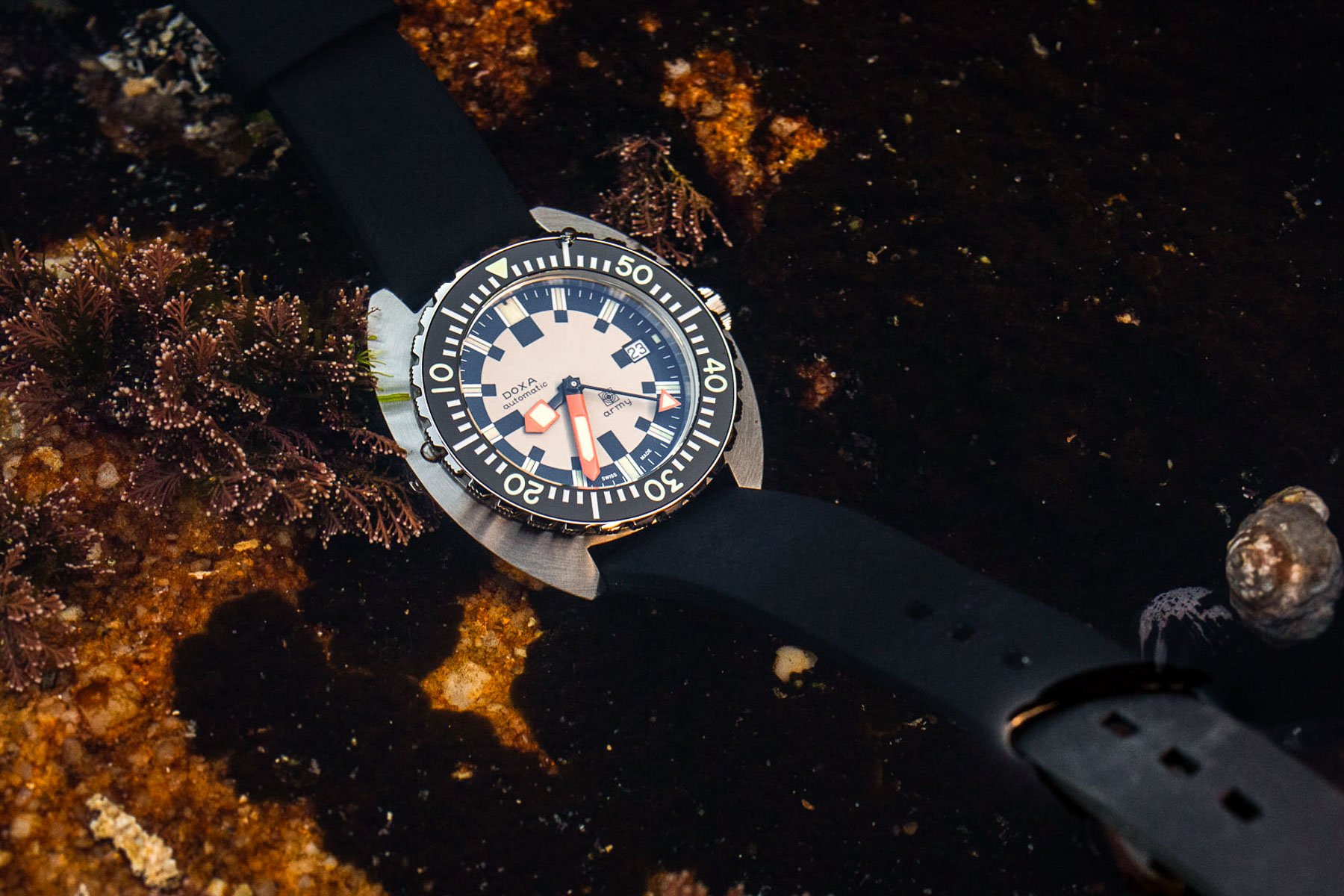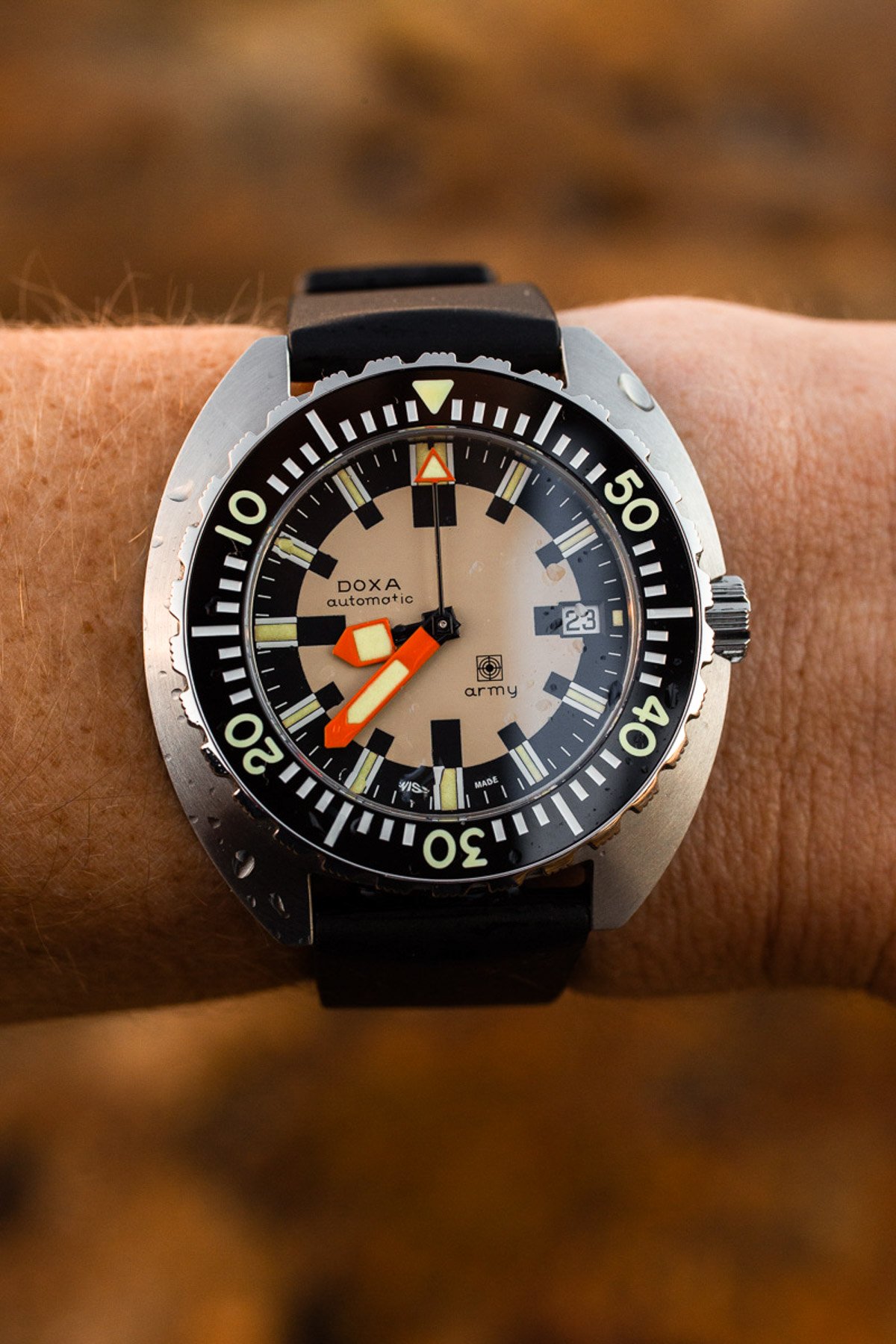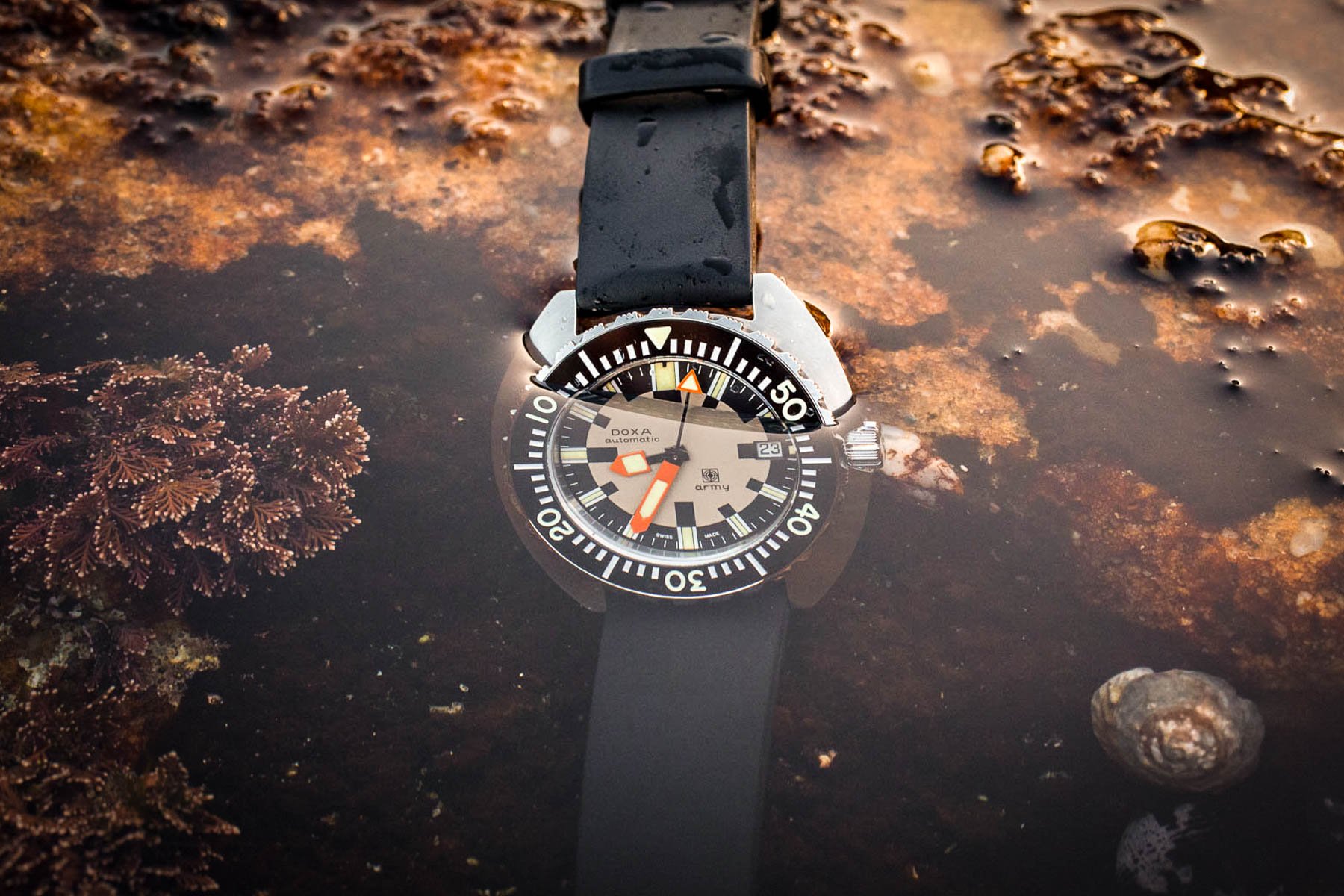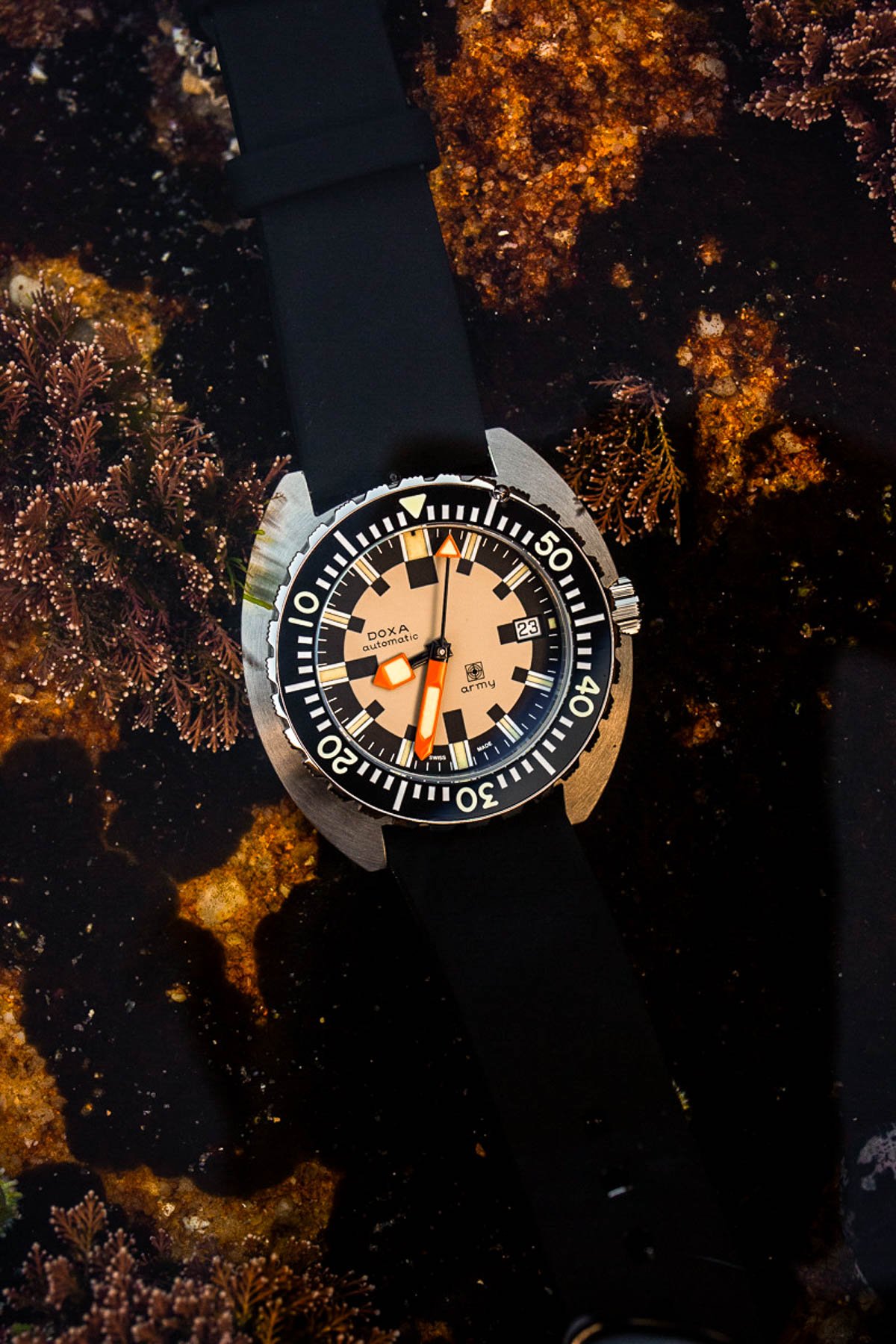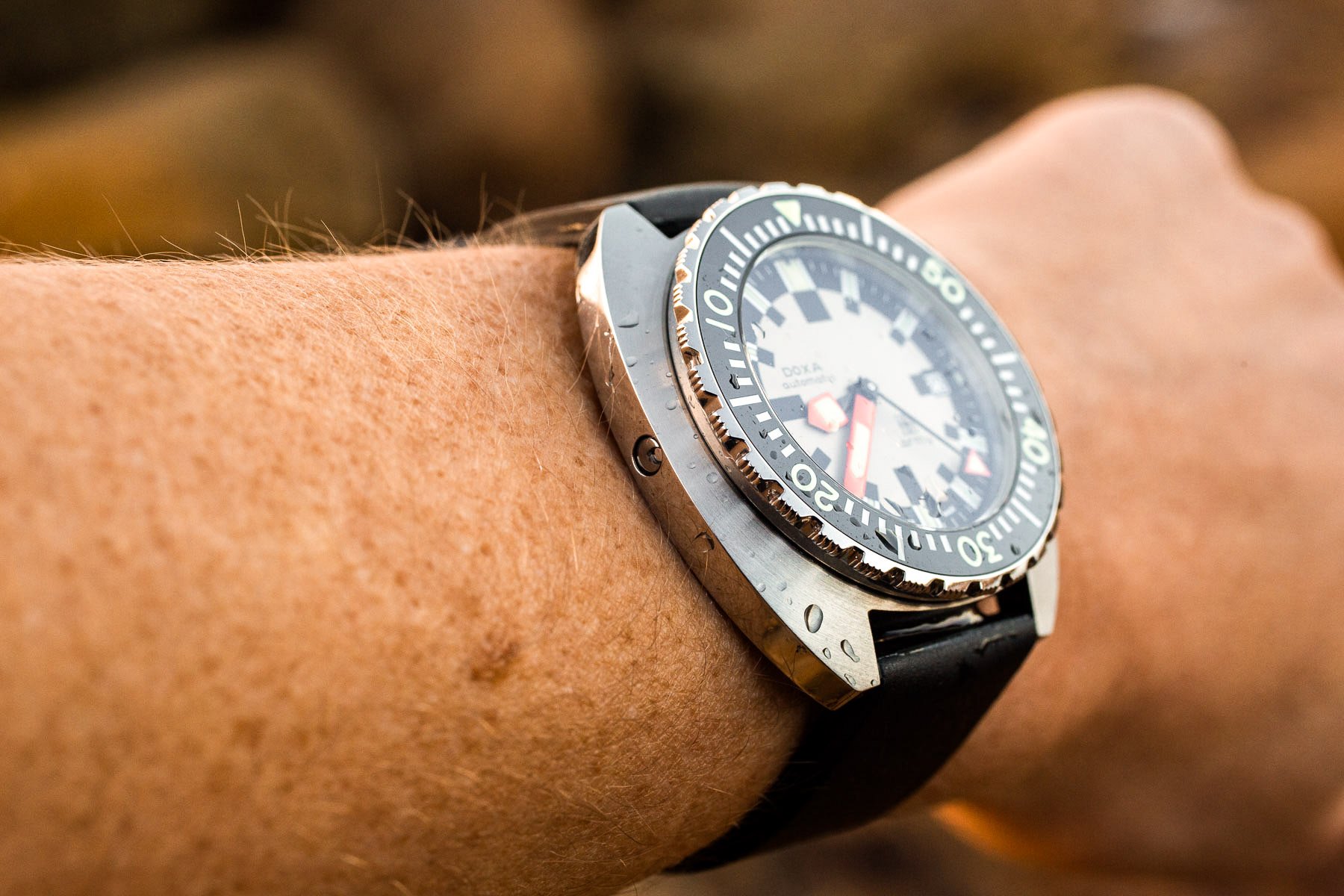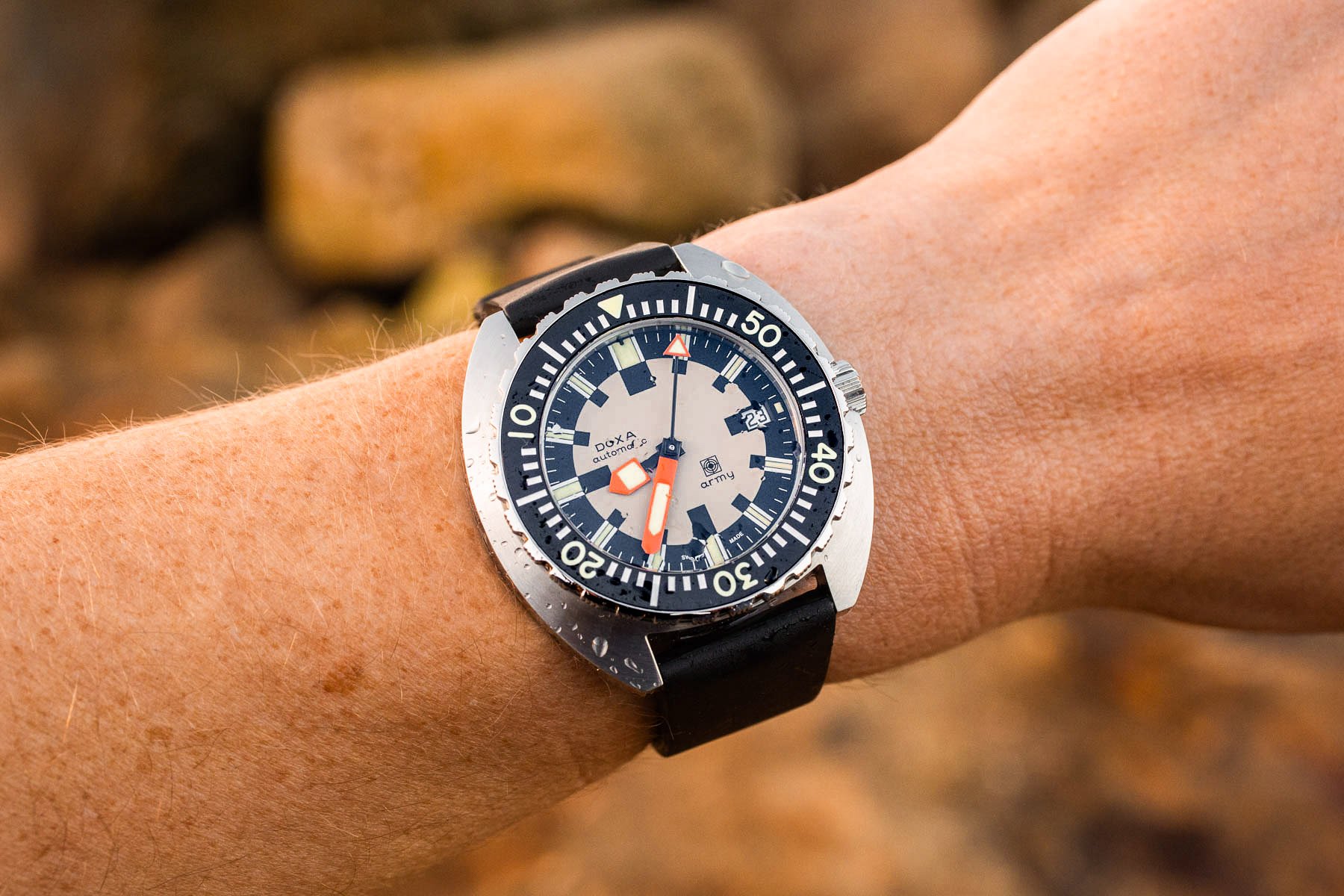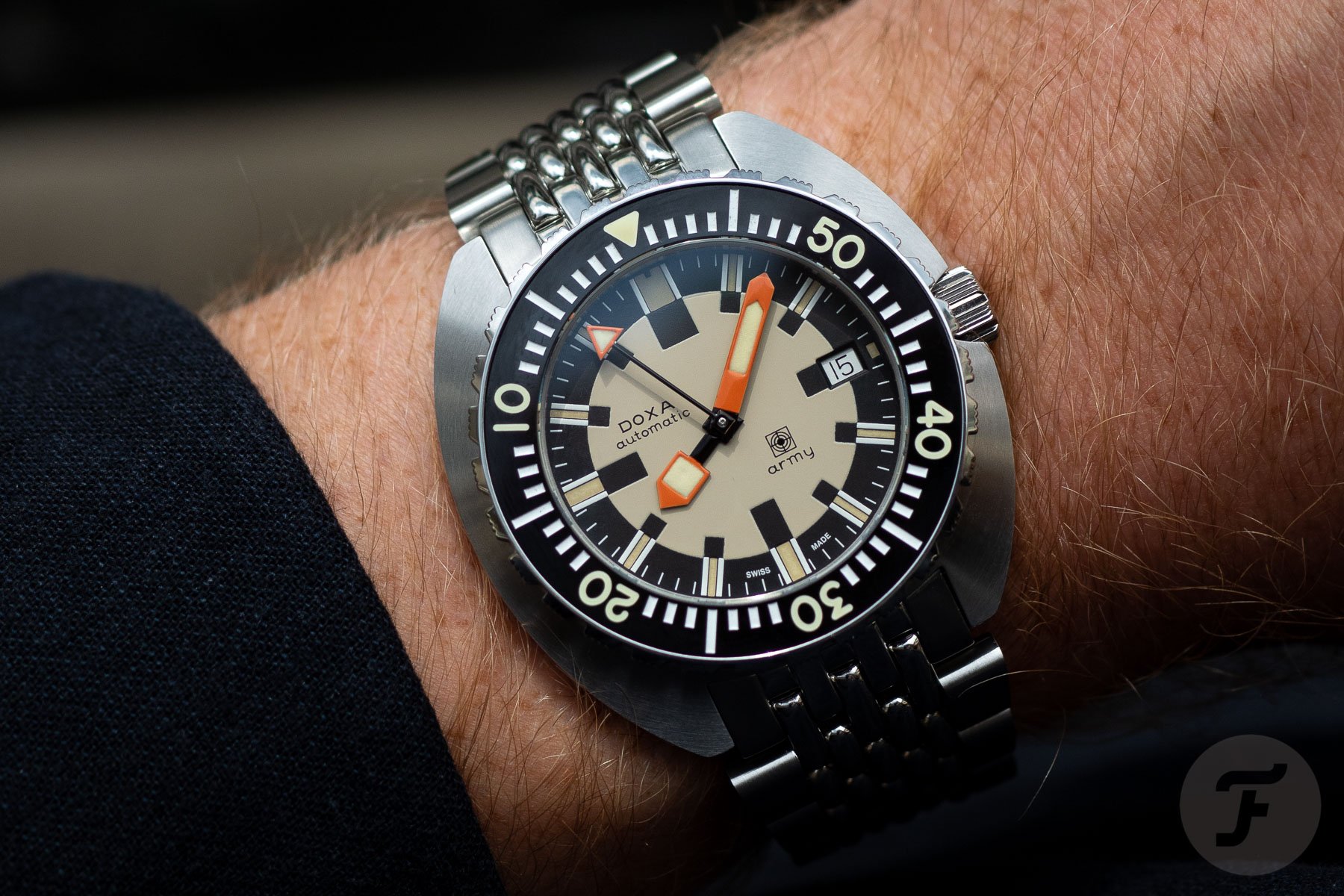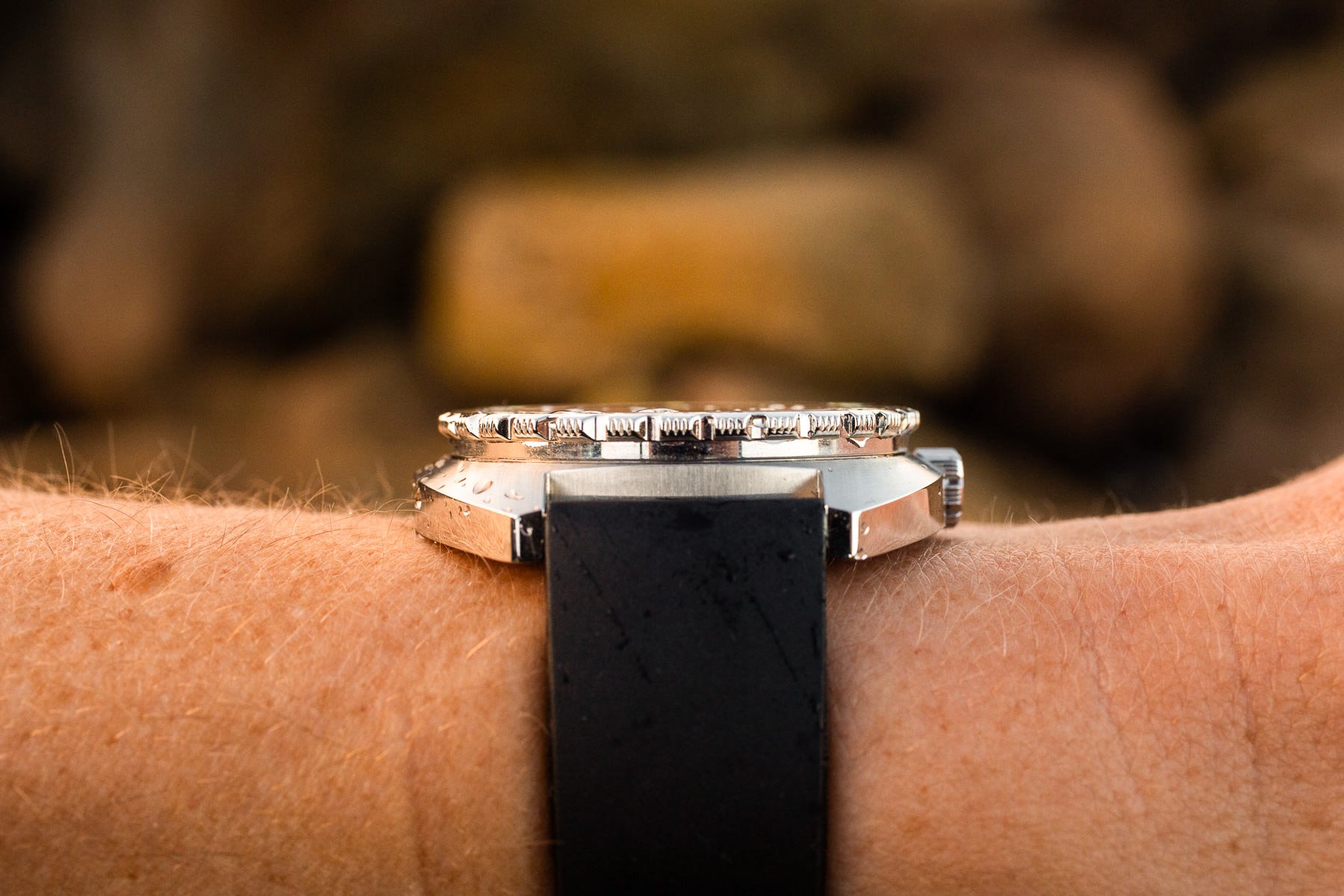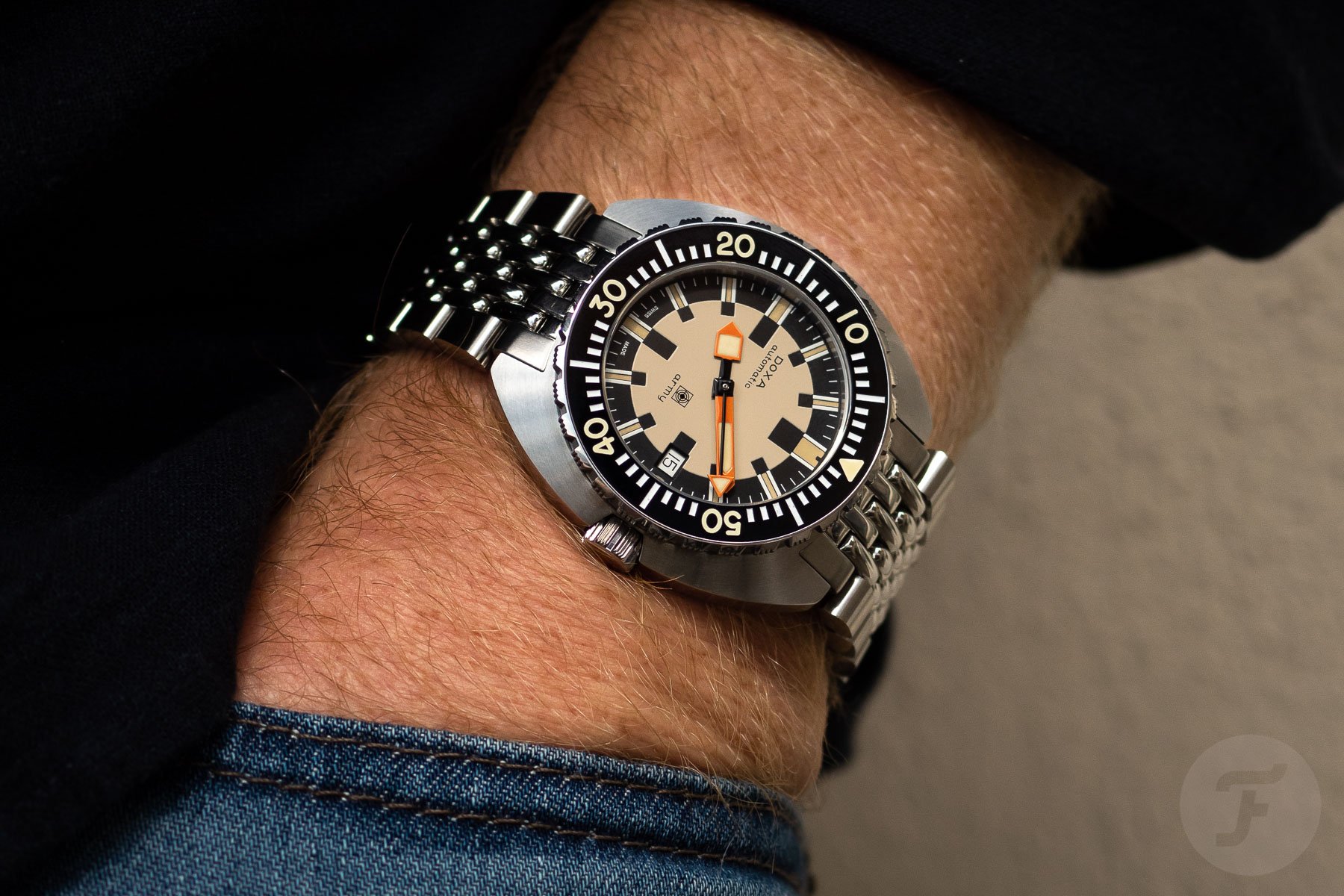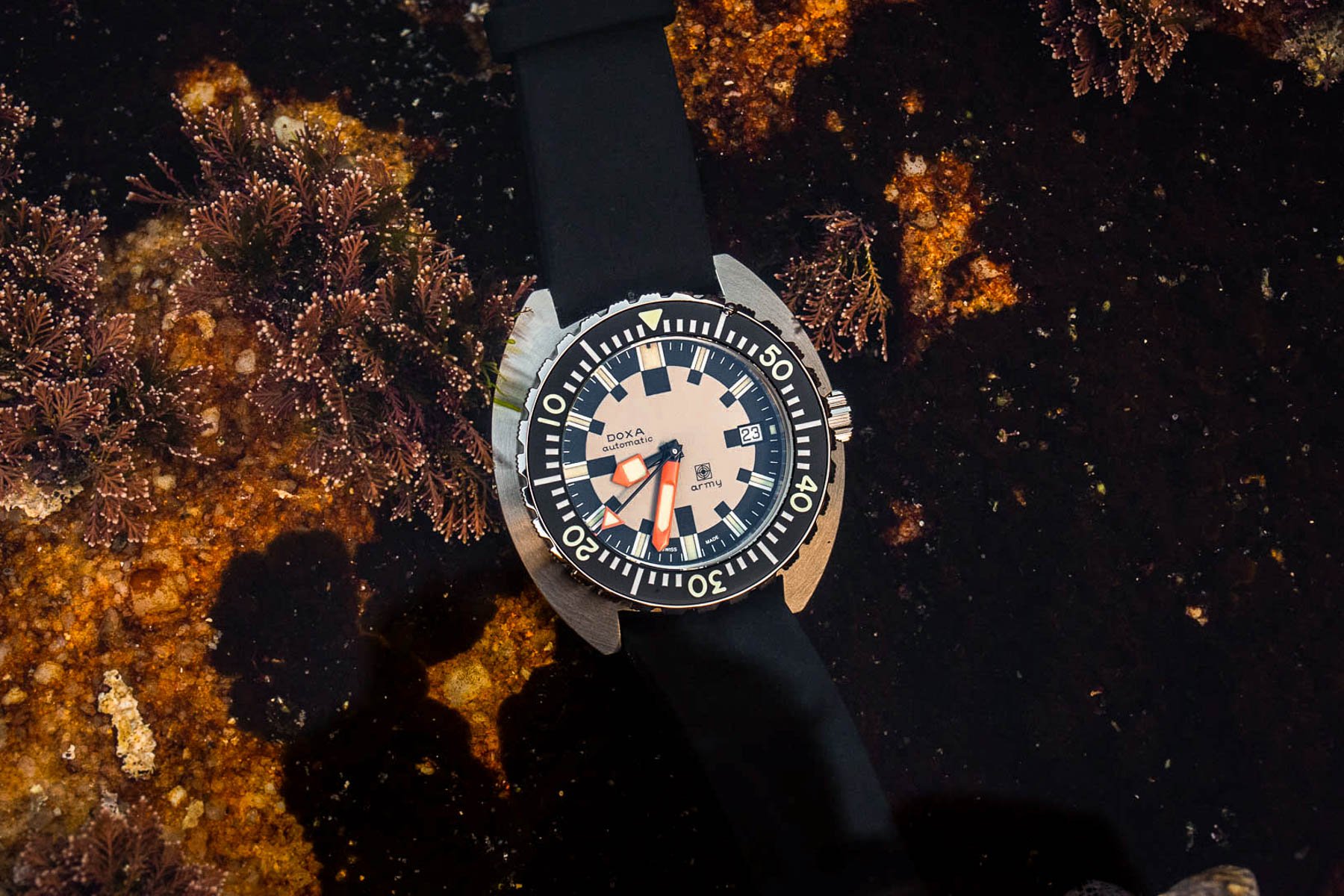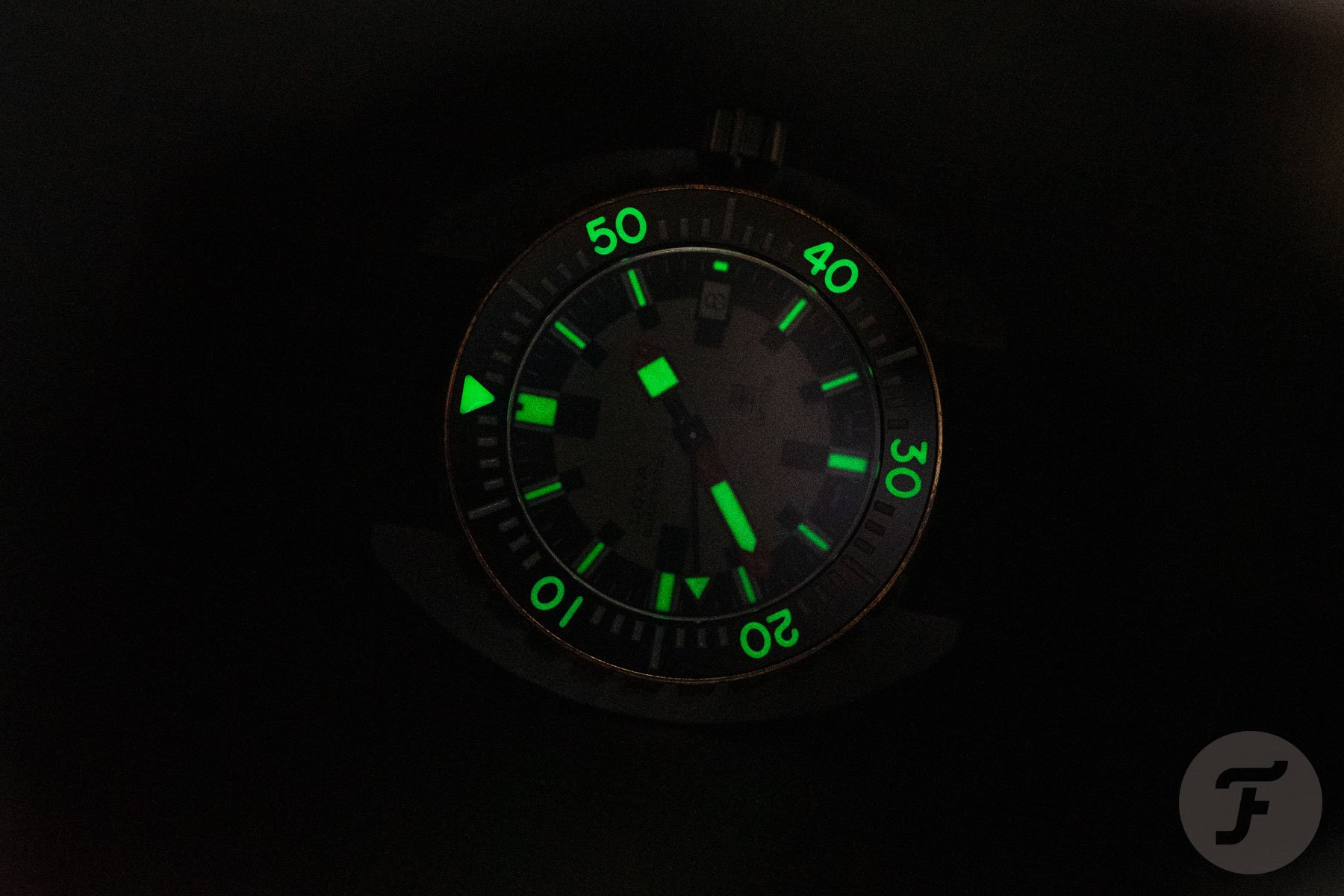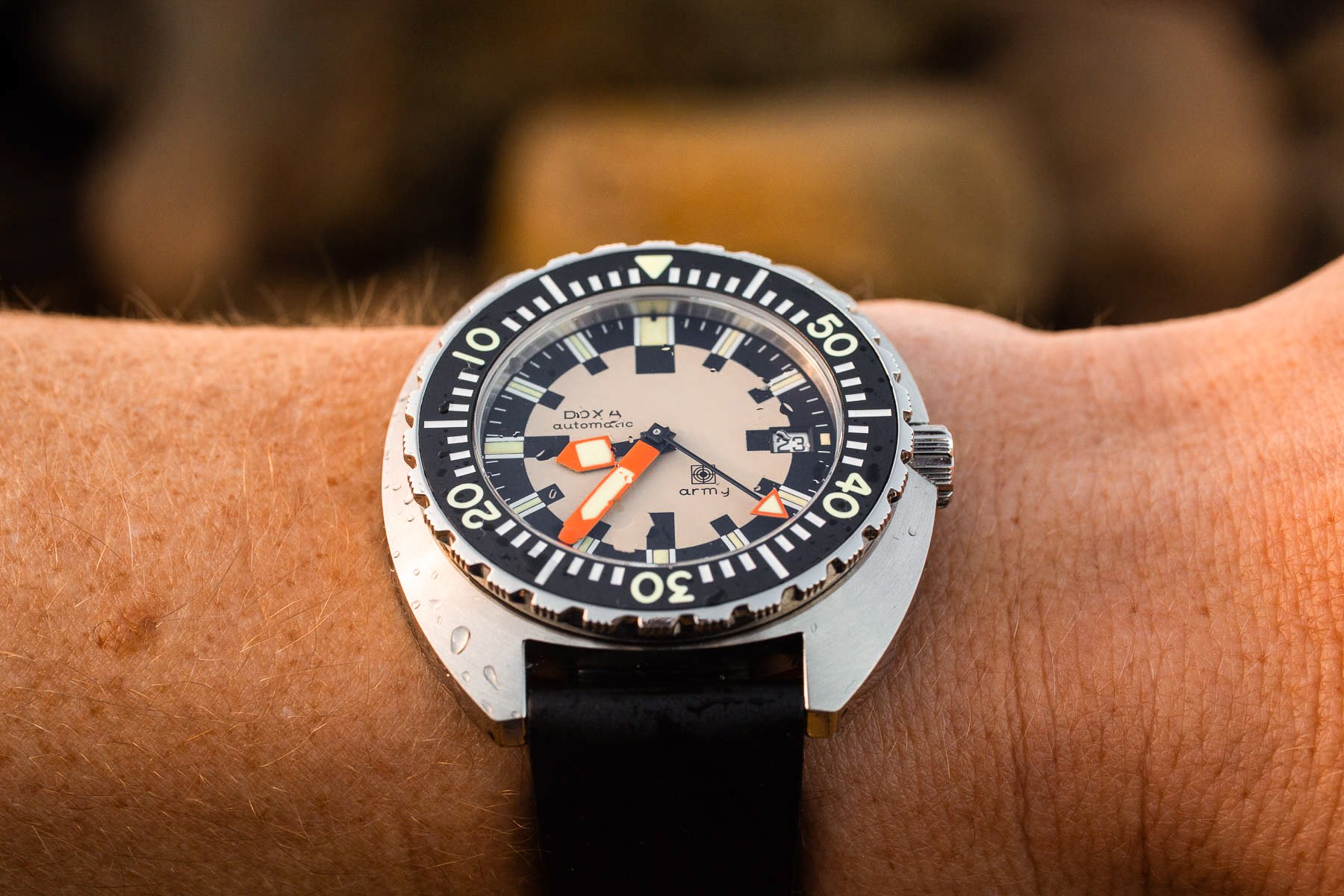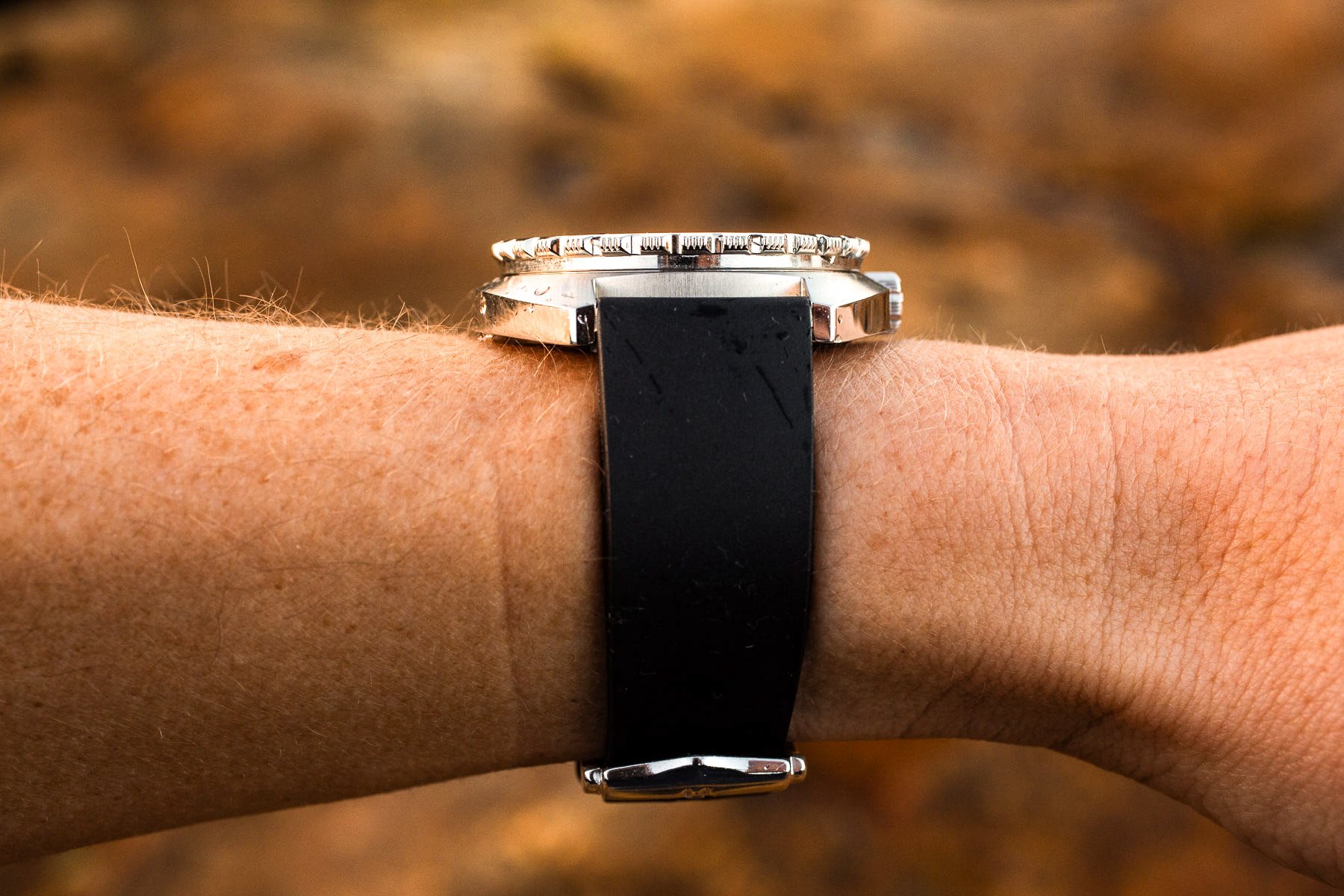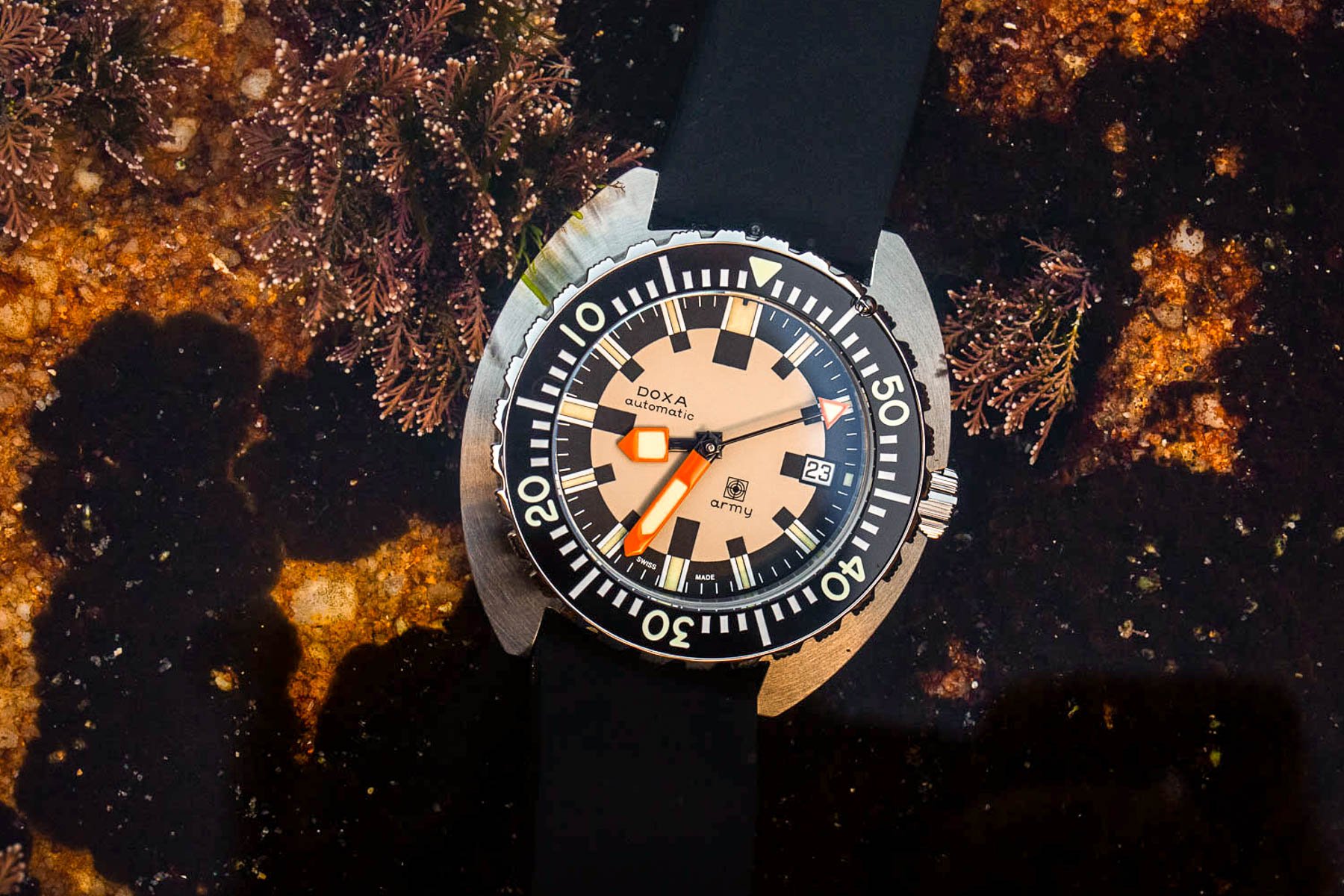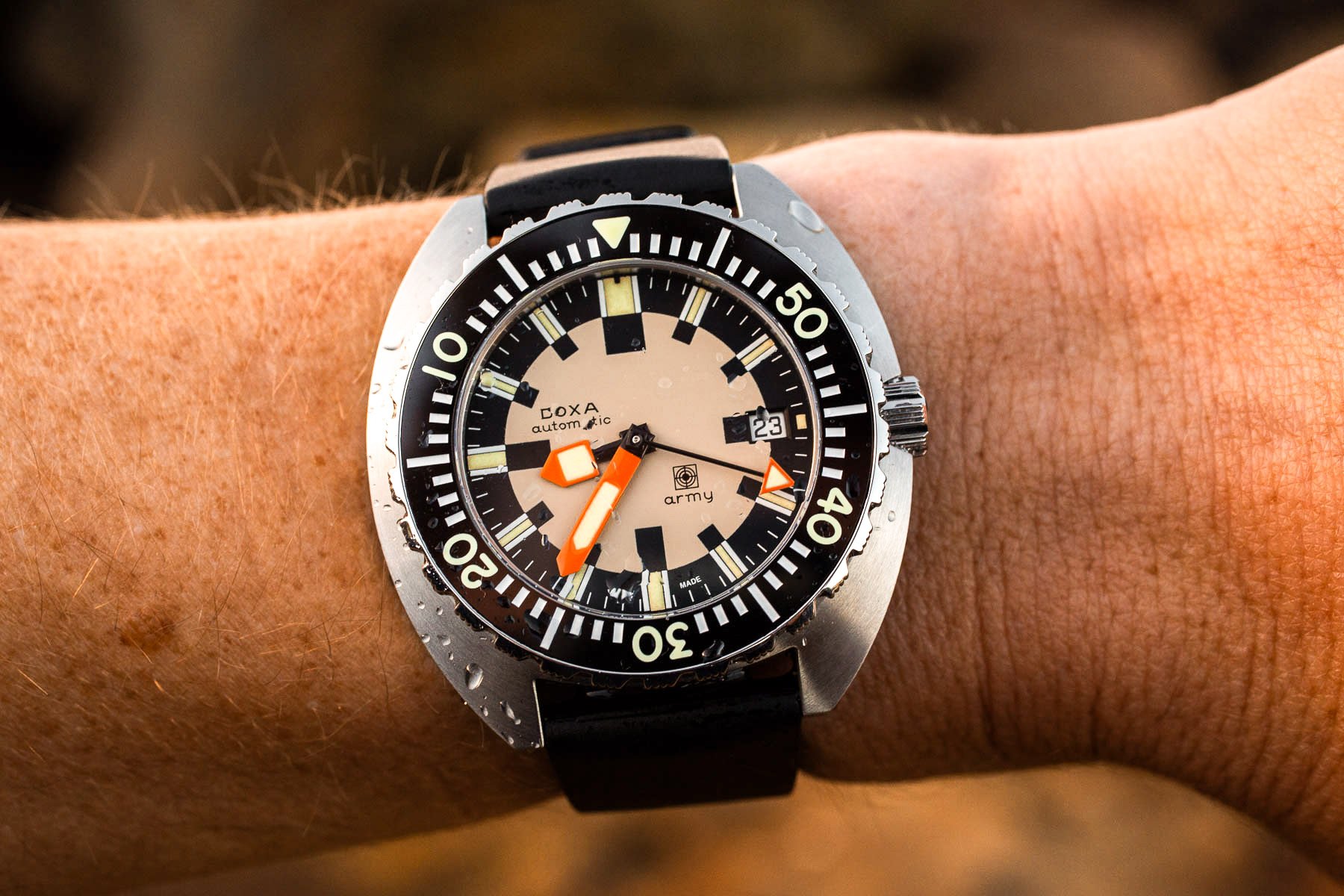Why the Doxa Army Is A Sleeper Hit That Stands Alongside Rolex, Omega, And Tudor
Close your eyes and imagine a watch; what do you see? Chances are it probably has a few general characteristics: it’s round, worn on the wrist, and fairly monochromatic. Many of us might think of something like a Rolex Submariner or a pilot’s watch (I think of something close to my IWC Mark XV when I perform this mental exercise). But few would probably think of a Doxa dive watch like the Army model when performing this mental exercise. The diving watch brand has a unique design aesthetic at a market point that sits beneath Tudor and Omega. However, the brand’s history matches that of those brands in terms of interest and richness. This makes Doxa somewhat of a black sheep in the market today, and I’d say that’s a good thing.
“Close your eyes and imagine a watch; what do you see?”
I was asked this question by a friend recently, and it made me think about some of the standardized watch designs we see in the industry. The sheer number of integrated bracelet sports watches, the traditional-looking dive watches, et cetera. This is surely driven by what the people (i.e. the market) want. And so it was time for me to rebel. I decided to avoid the norm and celebrate my latest life event (a new day job) with a new watch: The Doxa Army, probably one of the most unique-looking dive watches coming out of a major brand today. It was Nacho’s favorite Swiss mechanical dive watch release of 2022. It’s also a watch that I’ve been enjoying immensely since I picked one up earlier this year.
The Doxa Army
The Doxa Army is a re-edition of an exceedingly rare watch that was produced in the late 1960s. As Doxa tells it, the Army was a dive watch issued to members of the Swiss Military; some also found their way onto the civilian market. In my research, I have seen at least two Doxa advertisements, one in English and one in French, from the period showcasing this particular watch. The watch, the legend goes, was not as well-liked by the Swiss Military rescue divers, who preferred the orange-dialed Sub 300T Professional. It’s believed other members of the Swiss Military used these army watches instead.
Whatever the veracity of these stories, the watch was indeed used by some Swiss Military members, which is really cool. This puts it squarely in the same territory as military-inspired modern designs like military-issued Tudor Submariners, and the modern Tudor FXD Marine Nationale, as well as military-issued Omega Seamasters and Rolex Submariners. These watches, particularly the vintage ones, command significant price premiums over this modern Doxa Army reissue.
An interesting backstory
Doxa says that around 150 Sub 300T Professional watches were provided to Swiss Army divers by the end of the 1960s. It was during this time that Doxa says it developed the Doxa Army, as a dedicated tool watch for the Swiss Army and which went to market for the public in 1968 as the “ideal watch for military divers,” with a black case, black bezel, beige dial, and an orange handset. The watch was not a commercial success.
Like the Tudor FXD, you get a countdown bezel with some application for measuring elapsed time for underwater navigation. The Doxa Army’s bezel looks strikingly similar to Omega Seamaster dive watches of the era, which is natural enough considering that the same manufacturer of those bezels also made the bezels on the original Doxa Army (but in countdown, rather than count-up format). These military connections, which clearly had an impact on the design of the watch, make the Doxa Army the brand’s counterpoint to the Tudor FXD in my books, and it does so with panache. As an aside, check out this Fratello article for more background on bezels.
The Doxa Army is a vegemite watch
While it can be cool to have a military connection, the coolest element is how the Doxa Army looks so peculiar. It is what I would call a vegemite watch, fondly named after the divisive savoury spread so popular in my home country Australia. You either like it or you very much do not like it. Looking down at the watch and you are greeted with what can only be described as a checkerboard-like dial design that brings to mind what would happen if you had bullseye dial designs from the 1930s and 1940s mish-mashed with a game of Jenga, a sort of watch version of Tetris if you will.
Unlike the Sub 300 and Sub 300T, the Doxa Army forgoes a decompression bezel in favor of a more traditional countdown bezel (from the triangle at 60 down to 10), with big bold markers that have generous amounts of Superluminova present. The bezel breaks up the birds-eye view impression of the watch in a way I appreciate compared to the steel no-decompression bezels that create the overall impression of too much stainless steel to my eyes. Speaking of lume, I have owned several Doxa watches and handled more, including the COSC-rated Sub 300, the entry-level Sub 200, and the Doxa Sub 600T Pacific limited edition. The Doxa Army has the strongest lume application of any of these watches by a significant margin and comes close to my Tudor Black Bay Fifty-Eight.
Professional specifications matched with solid fit and finish
The Doxa Army re-edition closely matches the original with upgraded specifications: A 300-meter water-resistant rating, with an 11.95mm thick tonneau case, excellent applications of Superluminova on the hour markers and the numbered elements of the ceramic countdown bezel, and an ETA 2824-2 movement (not a Sellita SW200-1, as I’m referencing Doxa’s original press release here). The ETA 2824-2 is a welcome sight (well, behind a solid case back) and will ensure easy servicing for many years to come.
The movement is nothing fancy, but it does the job and does it well. The date wheel uses a font I have seen with the Doxa Sub 200 but not on watches outside the Doxa brand. Whatever the numbered font they use, I love it as it creates a subtle nod to a more 1960s and 1970s aesthetic; it’s all in the small details.
A slimmer case
The case of the Doxa Army is noticeably slimmer than the Sub 300T. Part of the reason is that the bezel was redesigned for this watch, as was the case back. These changes create a much superior wearing experience than the Doxa Sub 300T and are a welcome innovation by the brand. The case may be slimmer than the Doxa Sub 300T, but it still comes with a helium escape valve located on the left-hand side of the case.
The crown, with a black Jenny fish logo, feels excellent in operation and is as smooth as my Tudor. It neatly lines up with the logo facing downwards, or south, when fully screwed in. I have seen this with other Doxa Army watches, so I assume that this was intentional and speaks to the great amount of thought being put into the production of the watch. Readers, if you own a Doxa Army, can you check if this is the case for your watch as well to confirm?
Good looks are in the eye of the beholder
The case is neatly brushed on the top with polished flanks, creating a classy albeit toolish look which I love. The factory beads-of-rice bracelet is functional with an excellent adjustable clasp like that found on the Doxa Sub 300T, but with male end links which poke out of the case in a somewhat awkward fashion for those with smaller wrists. Because of this, I’m currently wearing mine on a Hirsch Pure rubber strap which slims down the entire wearing experience in a good way, but I enjoy wearing it on the bracelet with the clasp extension too.
The bright orange handset is uniquely Doxa. No watch comes close to looking like this Doxa Army except for similar renditions by Synchron and others that reference the design cues of the original watch. It was as highly legible in and out of the ocean, something I can confirm after exhaustive underwater testing. The seconds hand looks like a GMT hand, adding to the unique character of this timepiece. I prefer my stainless-steel cased version over the all-black look of the limited edition, referencing the blacked-case Doxa Army’s of the 1960s and 1970s.
A former titan in the diving world on its journey back
Doxa today is a brand that seems to be punching above its weight, producing well-made timepieces that are fairly priced and clearly resemble the designs of the brand’s halcyon era in the 1960s and 1970s. What I do love about Doxa is that it is a brand that stood shoulder to shoulder with Omega and Rolex in the ocean-going game, was at the forefront of design, and is a brand that has all of that history at truly attainable prices for us enthusiasts.
This is particularly important as Rolex and increasingly Omega pricing outpaces what we could reasonably say is affordable luxury. Tudor has filled the gap that Rolex has left behind and provides much of the quality and design flavor of Rolex at a more attainable price. But the great thing about Doxa is it is one of the significant dive watch brands, with incredibly unique designs and DNA of their own. From handling this Doxa Army compared to releases from Doxa in recent years, the build quality seems to have involved even more thought than usual; we’re talking almost Tudor quality on some of the feel of the parts on this watch. It is almost as if Doxa wanted to prove something with the Doxa Army.
A few niggles
There could be improvements with this watch. I feel that a version with a lighter-colored dial would probably be closer to how these looked straight out of the factory. The sand-colored dial, while handsome, does not provide the legibility factor that the egg-shell dial would provide underwater. When looking at vintage photos, it seems like the original Doxa Army watches had a lighter dial creating a more classical bullseye or tuxedo look.
I think the same argument could be made about the markers on the countdown bezel. Please, Doxa, make these white, and bring out a true competitor to the Tudor FXD; you’re almost there with this Doxa Army! Provide Superluminova on all of the minute markers of the dial, use a slightly lighter shade for the inner dial instead of the sand for greater contrast underwater, and you have an absolute hit.
Final thoughts
I genuinely believe that the Doxa Army delivers if you want a watch with unique looks and a cool backstory. It comes from a brand with rich history and has the quality to match. I believe this watch will be a sleeper hit in years to come. The more time I spend with mine, the more I love it. Even if my girlfriend says, it looks like the watch “a 10-year-old would wear.”
Maybe I am tapping into my inner child, and I love it for that. It will likely have you doing the same in a way that other brands would probably struggle to do. Shouldn’t that be celebrated? But what do you all think? Is the Doxa Army an ugly duckling that deserves respect? A sleeper hit even! Or should it have stayed in the past?

